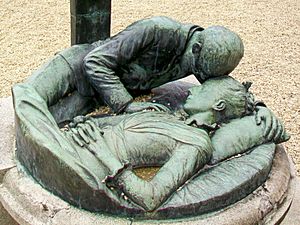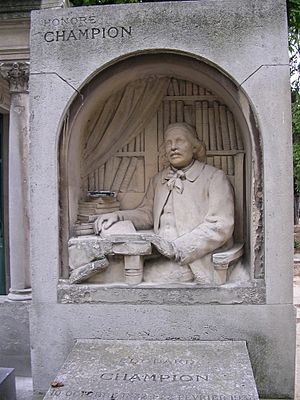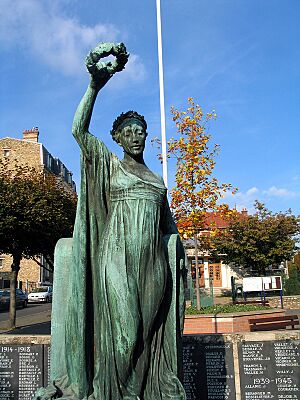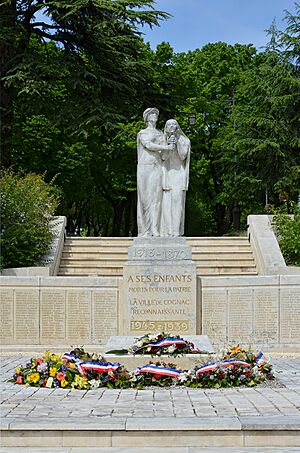Albert Bartholomé facts for kids
Quick facts for kids
Albert Bartholomé
|
|
|---|---|
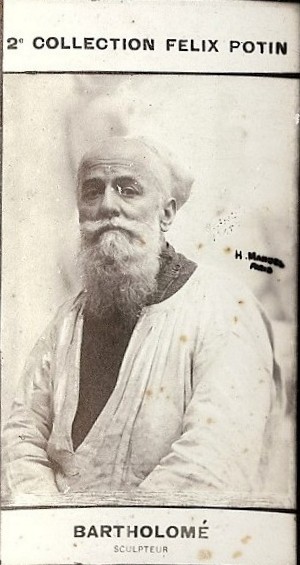
Albert Bartholomé
(Collection Félix Potin) |
|
| Born | 4 August 1848 Thiverval-Grignon, France
|
| Died | 1928 (aged 79–80) Paris, France
|
| Nationality | French |
| Education | École des Beaux-Arts |
|
Notable work
|
Fillette pleurant Croix de guerre |
| Movement | Romantic; Art Nouveau |
| Spouse(s) | Prospérie de Fleury |
| Awards | Grand Prize, 1900 Exposition Universelle |
Paul-Albert Bartholomé was a famous French artist. He was both a painter and a sculptor. He was born on August 29, 1848, in Thiverval-Grignon, France. He passed away in Paris in 1928.
Bartholomé won a big award, the Grand Prize for sculpture, at the World's Fair in Paris in 1900. He showed his paintings at the Salon (a famous art show) from 1879 to 1886. After that, he decided to focus only on sculpture.
Contents
Biography
Albert Bartholomé first studied law. He also fought in the Franco-Prussian War and was held as a prisoner in Switzerland. Later, he went to the École des Beaux-Arts in Paris. There, he studied painting with teachers like Jean-Léon Gérôme.
He opened his own art studio in Paris. He became good friends with another famous artist, Edgar Degas. Bartholomé married Prospérie de Fleury, but she sadly died young in 1887.
His friend Degas encouraged him to try sculpture. Bartholomé created a touching sculpture for his wife's grave in Crépy-en-Valois. This was his very first sculpture. After this, he worked only on sculptures. From 1891 onwards, he showed his sculptures every year at the Salon.
During that time, sculptures for graves were very popular in France. Many of Bartholomé's works are about death. His most famous work is a large monument in Père Lachaise Cemetery in Paris. It is dedicated to all those who have died.
He worked on this huge monument for ten years. It was officially opened in 1899. This "Monument to the Dead" is very powerful. It shows twenty-one figures, all larger than life. Each figure shows different feelings about death. The monument is very human and doesn't try to be overly emotional. It suggests that a "light" will overcome darkness. An inscription on it says:
"Upon those who dwelt in the land of the shadow of death a light has dawned".
Main Sculptures
Important Works by Albert Bartholomé
- "Little Girl Crying" ("Petite fille pleurant")
- This bronze sculpture was shown in 1894. You can find copies of it in different materials. For example, there's a marble version in Paris and a limestone one in Copenhagen.
- "Project for a Monument to the Dead"
- This is Bartholomé's most famous work. It is located in Père Lachaise Cemetery in Paris.
- He first showed parts of it in 1891. The final huge version, 10 meters long and 6 meters high, was shown in 1895.
- It was a huge success! The French government and the city of Paris asked him to create a full-size version in stone.
- The monument was unveiled on November 1, 1899. Almost 100,000 people visited the cemetery on that first day.
- The monument looks like an ancient Egyptian tomb called a Mastaba.
- At the top, a couple walks from life into death through the tomb's entrance. Other groups of people are around the entrance.
- Below, you see death itself, with a dead couple and their child. A figure called "the Spirit of life and light" reaches out to them.
- On the left, a group of figures hide their faces. They show the sadness of those left behind when someone dies.
- On the right, another group shows despair. These are people who are about to die and enter the tomb.
- Mask of Tadamasa Hayashi
- This bronze mask was made in 1892. Tadamasa Hayashi was an art dealer who helped share Japanese culture in Paris.
- Madame Guillaume Dubufe
- This marble statue was made in 1895. Guillaume Dubufe was a French painter. Bartholomé also made a sculpture for the Dubufe family tomb.
- "Adam and Eve"
- A version of this sculpture is in the Hermitage Museum in Saint Petersburg, Russia.
- The tomb of Henri Meilhac
- Located in Cimetière Montmartre in Paris, this tomb features a sculpture called "Douleur" (Grief).
- Tomb of Pam family
- In Cimetière Montmartre, Paris, this tomb has a marble sculpture of a caryatid (a sculpted female figure used as a column).
- Bust of Madame Bartholomé
- This bust was made in 1908. It shows Florence Letessier, who became Bartholomé's second wife in 1901.
- The tomb of Honoré Champion
- This tomb is in Montparnasse Cemetery.
- Monument to Jean-Jacques Rousseau
- This monument is in the Pantheon in Paris. It was unveiled in 1912.
- The main part shows three seated women. They represent "Philosophy, Truth, and Nature."
- Other sculptures like "Glory" and "Music" are also part of this monument.
- "Glory"
- The sculpture "Glory" was used for three war memorials. You can see a bronze version at the memorial in Cormeilles-en-Parisis.
- The Croix de Guerre
- Bartholomé designed the Croix de guerre 1914–1918 (France), a French military medal.
- Le Creusot War Memorial
- In 1919, Bartholomé was asked to create a memorial for workers who died in World War I. Although the full project wasn't completed by him, some of his figures were cast in bronze.
- Montbrison War Memorial
- This memorial was opened in 1920. It lists the names of soldiers from Montbrison who died in World War I. It also includes a bust of Emile Reymond, a politician and pilot.
- "Grief" ("La Douleur")
- The Musée d'Orsay has a marble copy of this sculpture. It was originally part of a monument for writers and composers who died in World War I.
- Monument aux Morts at Crépy-en-Valois
- This war memorial, opened in 1925, shows a woman crying over a dead soldier. Bartholomé created it for free to honor his first wife.
- Cognac War Memorial
- This memorial in Cognac shows two women holding a sword. One represents France victorious in 1918, comforting the other, who represents France defeated in 1870.
- Soissons War Memorial
- The war memorial in Soissons has four standing statues by Bartholomé. It also has carvings by another sculptor, Raoul Lamourdedieu.
- The monument was first designed by Bartholomé in 1914 to celebrate Soissons' history. Later, it became the city's war memorial.
- The statues at each corner show different parts of history, like a citizen holding a scroll or a knight with a sword.
- War Memorial at Palais de Justice Paris
- This memorial is inside the Paris courthouse. It honors members of the French justice system who died in World War I. It shows a judge placing a soldier's helmet on a lawyer's head.
Note
In 1924, Bartholomé made a monument for Victorien Sardou, a French writer. It showed Sardou seated, with figures representing comedy and drama behind him. Sadly, during World War II, the Germans took the monument apart to melt down the bronze.
Images for kids
See also
 In Spanish: Albert Bartholomé para niños
In Spanish: Albert Bartholomé para niños
- War memorials (Aisne)- See Soissons entry
- War memorials (Oise)-See entry on Monument aux Morts at Crépy-en-Valois
- In the Conservatory (Bartholomé)


